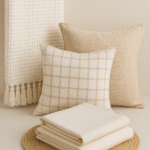
Joy Yesuraj
Operational Manager
When Shelves Look Full but Pockets Feel Empty: The Subtle Balance of Retail Stock
Walk into any beautifully arranged retail store — from home décor boutiques to lifestyle chains — and it’s easy to be charmed by the sight of full shelves. Rows of neatly stacked cushions, coordinated bedsheets, and folded towels create a sense of abundance. But behind that colorful comfort often lies a quiet struggle every retailer knows too well: the fine balance between display and dead stock.

In retail, especially in categories like home textiles, more stock doesn’t always mean more sales. It might mean more rent, more holding cost, and more capital trapped on the shelf instead of circulating through the business.
The Invisible Cost of “Plenty”
Retailers across the world face a common challenge — limited space and rising operational costs. Every square foot of a store must justify its presence. Too much inventory might make the display look full, but it silently eats into cash flow, delays the introduction of new designs, and reduces the freshness that customers crave.
This reality is particularly evident in lifestyle and home segments, where trends move faster than we expect. Consumers now look for variety and seasonality. A store packed with last quarter’s patterns, no matter how well-priced, can quickly lose its appeal. Retailers must constantly juggle between having enough for choice and not too much for comfort.
Stock Strategies Across Segments
Different retail formats approach this challenge differently.
- Value stores and hypermarkets rely on visual abundance — customers there prefer volume and variety, and full shelves signal value.
- Premium or departmental stores, on the other hand, win through freshness and finesse. Here, too much stock can dull the experience, making even the finest collection feel repetitive.
The key lies not in size, but in speed — how fast stock moves and how quickly new collections arrive. Cash that keeps moving keeps the business alive.

The Global Retail Pulse
Retailers overseas face similar hurdles, though the landscape may differ — higher labor costs, warehouse constraints, longer logistics timelines, and unpredictable consumer moods. Whether in London, Sydney, or Dubai, the pain points echo the same rhythm: how to maintain visibility without overstocking, how to stay trendy without heavy carrying costs, and how to keep the store floor agile when supply chains stretch across continents.
Working With the Retailer’s Rhythm
The best partnerships in retail today are built on understanding this rhythm. It’s about knowing when a retailer prefers speed over bulk, design rotation over storage comfort, and flexibility over rigid supply models.
Behind every successful sourcing or merchandising relationship, there’s empathy — the understanding that convenience, cash flow, and adaptability matter as much as quality or design.
Because in the end, retail isn’t just about what looks good on the shelf — it’s about what keeps the business moving.




